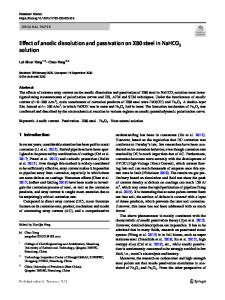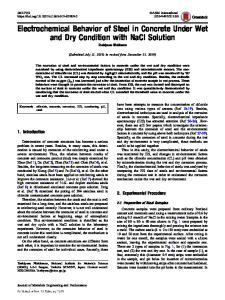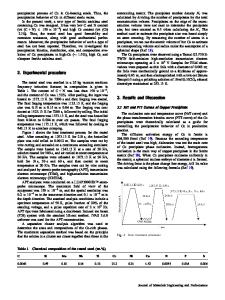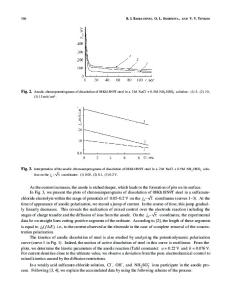Electrochemical dissolution behavior of S-04 high-strength stainless steel in NaNO 3 aqueous solution
- PDF / 5,709,642 Bytes
- 15 Pages / 595.276 x 790.866 pts Page_size
- 111 Downloads / 350 Views
RESEARCH ARTICLE
Electrochemical dissolution behavior of S-04 high-strength stainless steel in NaNO3 aqueous solution Minglu Wang1 · Ningsong Qu1 Received: 9 December 2019 / Accepted: 17 August 2020 / Published online: 18 September 2020 © Springer Nature B.V. 2020
Abstract The excellent strength, toughness, and corrosion resistance of high-strength stainless steel has led to its extensive use in the chemical, nuclear, aerospace, and aviation industries. To shape this hard-to-cut material, electrochemical machining is a promising process. However, few reports have focused on the electrochemical dissolution behavior of high-strength stainless steel. Therefore, we focus herein on the electrochemical dissolution behavior of S-04 high-strength stainless steel in NaNO3 aqueous solution. The current efficiency indicates that current density can be divided into three regions (I, II, and III). Interestingly, a black machined surface appears in regions II and III, and the machined surface is shiny for region III. X-ray photoelectron spectroscopy indicates that the black machined surface is mainly due to the presence of Fe3O4. In addition, γ-Fe2O3 was also detected on the black machined surface in region III, whereas both γ-Fe2O3 and α-Fe2O3 were also detected on the black machined surface in regions I and II. Moreover, dissolution morphologies examined by SEM/EDX at different current densities and machining times showed that a good surface finish of the S-04 specimen can be obtained in region III. Finally, grooves with black surfaces in regions II and III were obtained by electrochemical milling. Graphic abstract
Extended author information available on the last page of the article
13
Vol.:(0123456789)
1150
Journal of Applied Electrochemistry (2020) 50:1149–1163
Keywords Electrochemical machining · S-04 high-strength stainless steel · NaNO3 aqueous solution · Current efficiency · Oxide layer · SEM/EDX
1 Introduction High-strength stainless steel is a type of maraging steel that can be strengthened by aging treatment, which results in precipitation hardening between intermetallics in a low or ultralow carbon martensite matrix [1, 2]. Its excellent strength, toughness, and corrosion resistance at elevated temperature has led to its extensive use for manufacturing heavy load components in applications in the chemical, nuclear, aerospace, and aviation industries [3, 4]. However, heat treatment of highstrength stainless steel makes it excessively hard, leading to poor machinability for traditional mechanical machining [5–9], which accelerates tool wear and increases processing costs. For difficult-to-cut materials, electrical discharge machining (EDM) [10, 11] and electrochemical machining (ECM) [12–14] are two commonly used processes. Unlike EDM, ECM leaves no recast layer on the workpiece surface. In addition, ECM also causes no tool wear, no thermal stress, no residual stress, and no cracks and burrs. ECM is thus a promising method for shaping hard-to-cut materials and has been widely applied to machining titaniu
Data Loading...











